As has been the case for more than two decades, the first race of the 2012-13 snocross season offered some insight on the sport, the riders and their machines.
I went to Duluth seeking to understand where Team Arctic stood compared not only to the competition, but also to last season.
Why compared to last season? Because for a team accustomed to winning proportionally more races that their investments in the sport, last season was a disappointing eye opener. Compared to the fully-developed competition, the then-all-new ProCross-based race sled was rough around the edges and in need of testing, calibration and improvement.
But that’s exactly why Arctic Cat races. And the investment to race a production-based snowmobile will pay off in ways that will benefit the racers and us regular riders.
So did the increased ground clearance, wider ski stance and other improvements to the 2013 Arctic Cat Sno Pro 600 make a difference for Team Arctic?
Without a doubt! Even if the final results don’t show it.

If the size and number of race transporters is an indicator of sport’s health, then this photo suggests that snocross is strong if not robust.
More than 100 race entries in the Sport category harkened back to the happier time pre-economic meltdown, and hopefully indicates a better future.
I appreciate the pomp and wow of a pits filled with such investment, but I worry that snocross has become a sport mostly of wealthy families and teams. The days of showing up at Duluth with a 24-foot enclosed trailer were over about five years ago. I’d hoped that the climb out of the Great Recession would bring with it a downsized approach, but it doesn’t appear to have materialized.
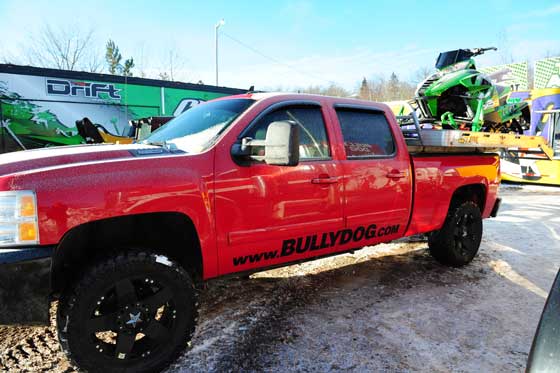
I suppose you can show up and race out of the back of your pickup truck, but spending $60k on your truck sort of defeats the purpose.
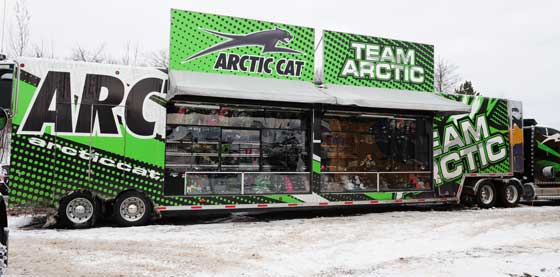
The new Team Arctic Support Trailer made its first appearance at Duluth and is a big improvement over the previous rig.
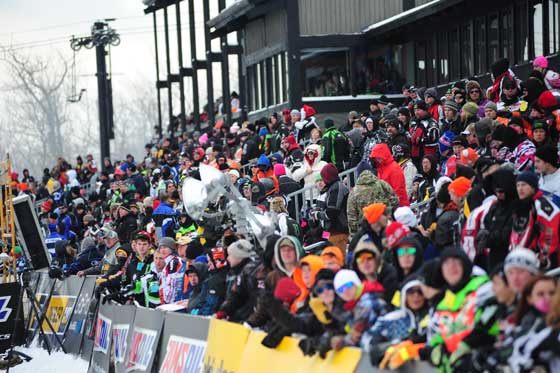
Every year the city of Duluth claims that 30,000-plus fans attend Duluth. I tried counting this year but ran out of time. I’d say that the crowd was smaller than previous years. The stands were never totally packed and there was only a small crowd at the top of the hill.
In an age where myriad social media bombard the plugged-in fan with hype and promotion of upcoming events, you’d think that Duluth would have more spectators than ever before. Maybe the fact that we can see a live-feed of each day’s racing, or make a few mouse clicks to see the results within moments of posting, is the reason why fewer people attend the races?

Warm temperatures the week prior led to a lot of nail chewing and hand wringing about whether to run the race. Officials made the right decision, but the consequence was a tiny race track with fewer jumps, dirt in the corners and almost no room to pass.
For a track that has never been great for “open” racing, Duluth set a new premium on the holeshot, which made for some of the least dramatic racing that I can remember.
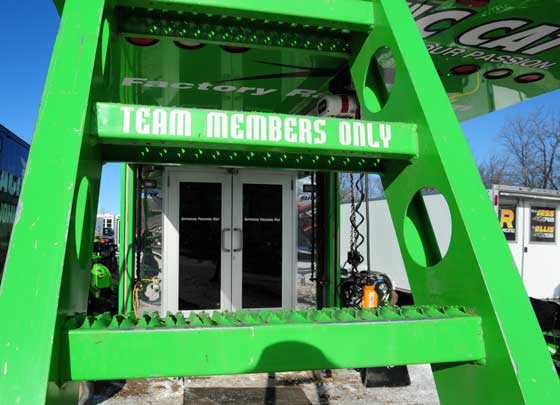
What we see on the track at Duluth is really the show… the icing on the cake, if you will. It’s what happens inside the race trailers that sets the stage. As much can be learned about a team and rider by watching what happens here as can be learned by watching the race action.
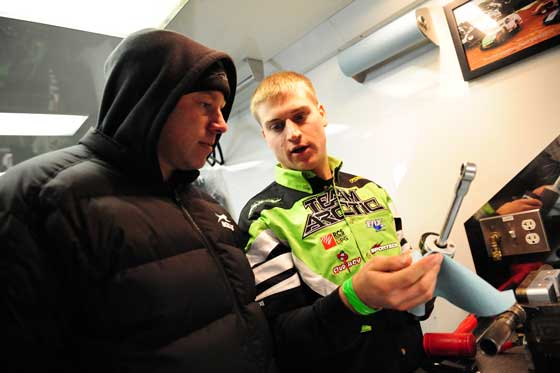
Inside the Factory Team Arctic trailer, Race Manager Mike Kloety (L) talks with new crew chief Dan Ebert (R).
With only one week of testing the new machine (much of it without racer Cody Thomsen who had suffered from food poising) the Factory crew was surprisingly upbeat despite the seat time deficit.
In fact Ebert logged most of the seat time himself, and he was quick to point out that the new Cat Mod sled was leaps and bounds better than last year’s machines.

Over the years I’ve learned that as much can be learned from a rider’s or team’s body language as can be learned from what they say.
Last year at Duluth most of Team Arctic wore a look of concern and uncertainty.
This year there was smiles and laughter inside the trailers, as evidenced here by factory pilot Cody Thomsen (L) and Arctic Cat VP Roger Skime.

Rules in the Pro Open class allow for a lot of leeway on chassis. Last year the Cat riders went into Duluth with very stock machines and found themselves outgunned by other teams who came with fully-tricked out machines.
This year, Arctic Cat came to Duluth with lightened machines incorporating some new ideas. I like that. And every Pro Cat racer I talked to raved about the new machine.

Steve Houle of Speedwerx is always a busy man at Duluth, floating between the trailers of all top Arctic Cat race teams to dial-in the clutching and discus the motor package they provide.
This year in the Pro class, the engine rules require a stock bottom end, cylinders and intake, but teams can change the exhaust and heads/combustion chambers. With the stock Sno Pro 600 engine producing around 130-hp with race gas, it’s probably safe to say that the mod engines are hitting numbers in the 150 range.

One new face in the Factory Team trailer was mechanic Mitch Rowland, whose family owns the Arctic Cat dealership Thomas SnoSports in Ogilvie, Minn.
It’s good to see new people engaged as race techs, especially since the days of the racer-mechanic are now officially over. Guys like Dan Ebert and Mitch Rowland could very well become the Steve Houles and Kirk Hibberts of the next decade.

More smiles were seen inside Tucker Hibbert’s race trailer. Here Mandi Hibbert (L), Kevin and Tucker (R) chuckle following a rousing rendition of “Happy Birthday to You” sung by the crew to Mandi.
With big sponsorship expectations weighing on his shoulders (not to mention his own powerful desire to win), Tucker comes into each race season with a level of seriousness and responsibility that’s probably different and more demanding than most of his competitors.
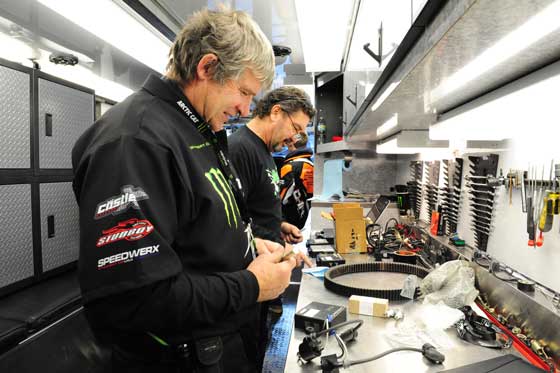
Kirk Hibbert was also wearing a smile on Saturday morning, and not just because Houle was telling jokes.
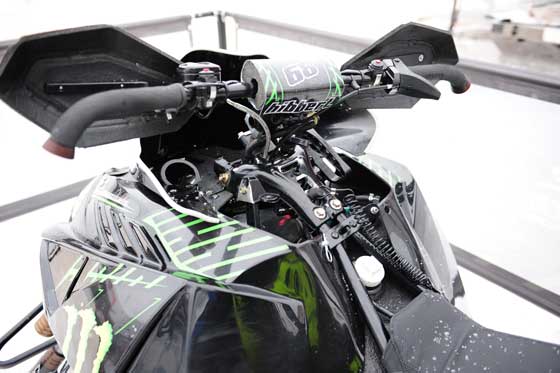
Train your eyes on Tucker’s sled and you will see creativity in the form of lightening and ergonomics.

While the Pros get much of the attention, the Transition and Jr. classes hold the future of the sport. Here Jeff Wittwer (L) poses with his son, Trent, who has terrorized the 120 and Transition classes for the past several years.
This year Jeff is employed as a mechanic on the Arctic Cat Factory Team and responsible for helping to further develop set-up information for the younger classes.
Speaking of younger classes: Team Arctic racers finished first and third in both of the Junior classes this weekend! Ian Buchman scored a win in Jr. 16-17 with Ryan Trout taking third, while Grant Glashagle topped Jr. 14-15 with Austin St. Cyr finishing third.
Plus Team Green racers swept the Transition 8-12 final, with Carson Alread, Evan Christian and Taylor Cole going 1-2-3 (although Alread did it on a Ski-Doo Freestyle, darn it).
These racers might be the next generation of top pros.
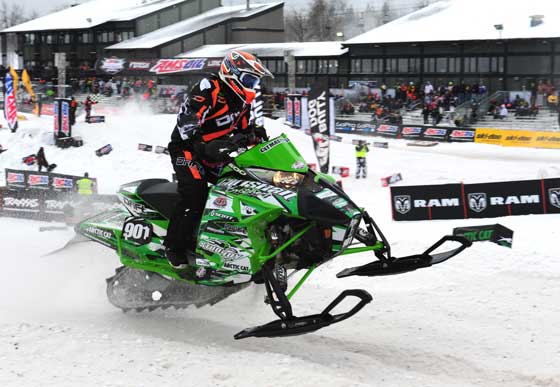
Joel Westerlund of Sweden is one of several Scandinavian racers competing at Duluth. He was one of a handful of Team Arctic racers in the Pro Lite (aka Semi Pro) class.
Like last year, Arctic Cat has far fewer numbers in the Pro Lite and Sport classes compared to the competition. It’s a conundrum that race manager Mike Kloety wrestles with: how to compete with teams who have upwards of twice (or greater) your budget? The answer “spend more” doesn’t magically make the purse strings loosen up, and so Kloety sticks to Arctic Cat’s long held method of growing its team from the grassroots.
The disparity in race budget is even more visible at Duluth, where 5-7 Canadian and regional race teams show up and their racers “downgrade” into smaller classes. I don’t understand how the top Canadian pros can show up and race Pro Lite at Duluth, but that’s what’s been happening the past couple years and that’s who wins.
Just as unsavory, there are other riders who are paid to stay in a lower class. I’m aware of one Polaris rider whose ability is definitely Pro Lite, but was offered free sleds only if he stayed in the Sport class.
All of this sandbagging produces a very unlevel playing field, especially at Duluth. Is it good for racing?
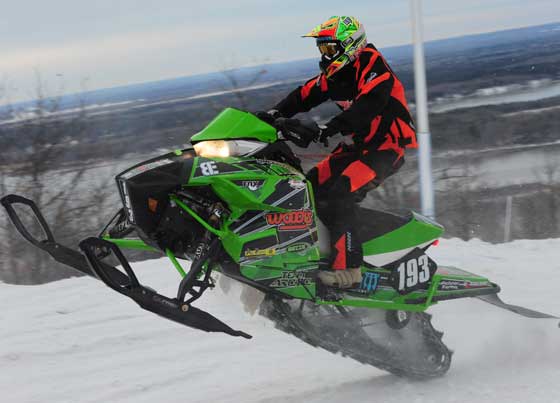
One Pro Lite Cat racer whose been trying to break into the top-five at Duluth is Matt Pichner, who made final on Sunday.

Last year Megan Campbell left Duluth injured. This year she left with a fifth-place finish in the Women Pro Am final. Much better, Megan!
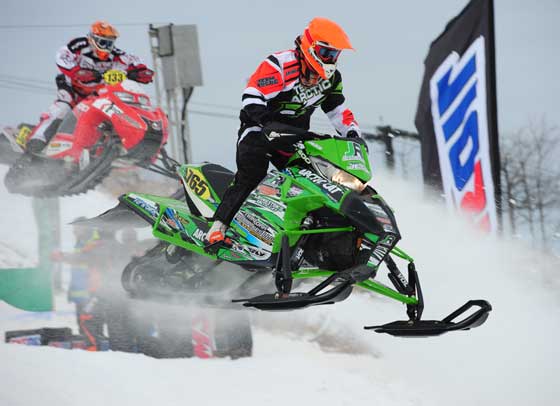
Arctic Cat’s Montana Jess races in the Sport class.
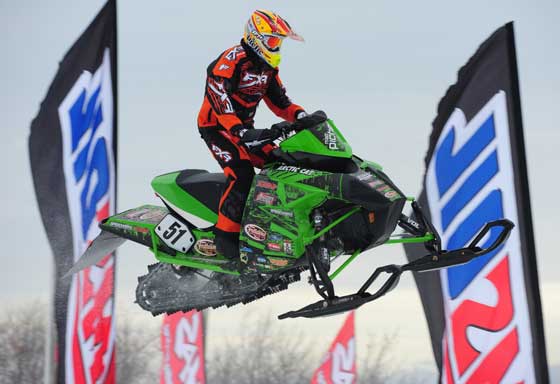
Matt Piche is one of a handful of independent Pro racers who can break into the top-10 on any given weekend. Unfortunately, it didn’t happen for Piche at Duluth.
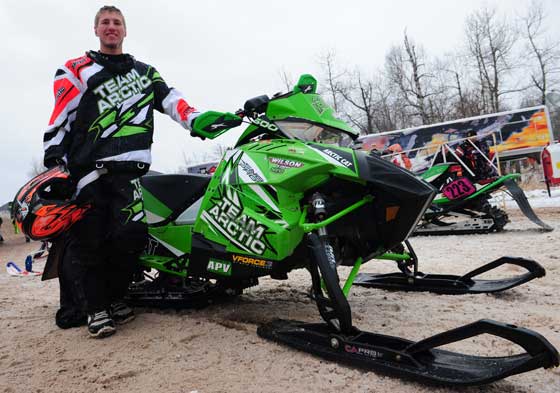
Having raced Ski-Doos for several years, Riley McClelland moved to Arctic Cat this season (in addition to jumping into the Pro Lite class) and is happy for the switch. When I asked him to compare the machines, he said the Cat corners better and is more predictable. He’s happy with the machine and is looking forward to getting some more seat time.
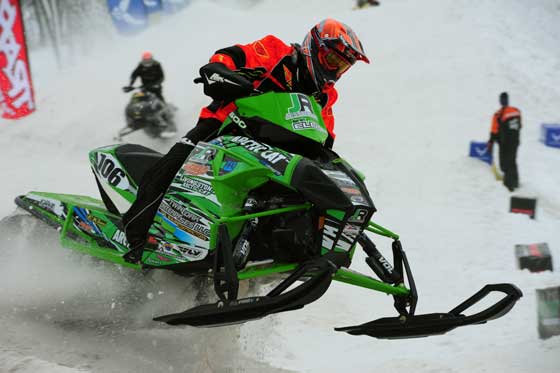
Another new face on Team Arctic is Pro racer Derek Ellis, who scored a 12 in Sunday’s final.

Christian Bros. Racing (CBR) Pro Garth Kaufman was the victim of some overly-aggressive racing at Duluth and didn’t make either final.
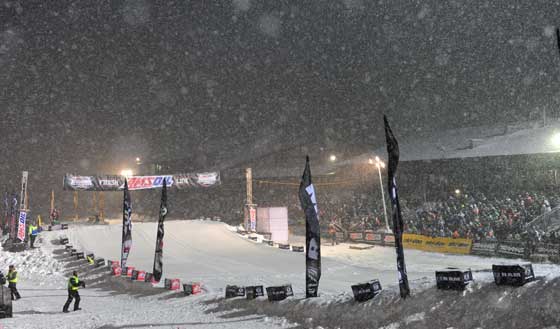
A Saturday night snowfall beautified the town and got the juices flowing for the spectators, but it made for some hairy visibility for the racers.

CBR’s Logan Christian is physically 100% and looking strong, finishing seventh in Pro on Saturday and 10th on Sunday.
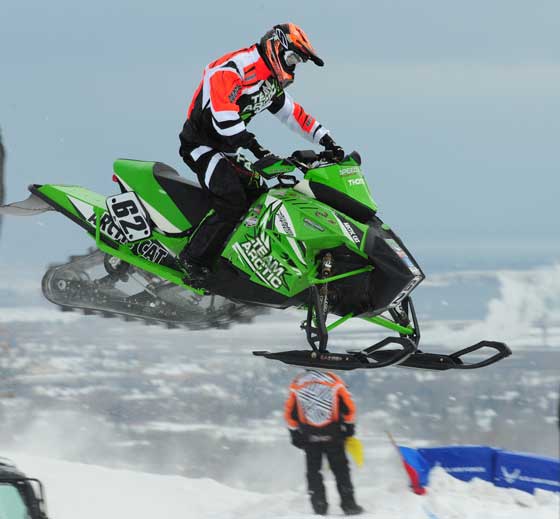
Factory Pro Cody Thomsen showed he’s more than ready to challenge in the Pro class this season, finishing fourth on Saturday. In Sunday’s final he was running in fourth when, after getting tagged by another racer, the torsion spring retainer on the skidframe broke and the spring speared the track, stopping him in his tracks.

Thomsen talks to Arctic Cat engineers Brian Dick (L) and Dayne Efte (middle) following the untimely break.
Thomsen has a cool head. And he’s fast, winning two heats during the weekend.

Coming into Duluth, Tucker Hibbert was feeling good. The lacerated kidney from last season is fully-healed; he’s happy with his new Mod sled; and he’s as hungry as ever to keep winning.
In Saturday’s final he found himself with a midpack start and only 24 laps to move up (on a track with very little room or features that allowed passing). He quickly worked his way into fourth, right behind defending champ Tim Tremblay, who is quite fast and difficult to pass even if he’s racing clean.
Tucker passed Tremblay once, only to get literally driven off the track a moment later. Back on the track, Hibbert once again quickly caught up to Tremblay and passed him yet again. But then disaster struck, with Hibbert uncharacteristically falling off on the uphill straight. He remounted and finished fifth.

On Sunday Hibbert suffered more bad luck. On the first lap of the final, his skis were run over which bent a steering arm, causing massive toe-out (spreading) of the skis. With his sled drastically darting, Hibbert spent the next five laps deciding whether or not he should pull off. Once he made the decision to stick with it, he moved through traffic and into fifth place.
Hibbert was the fastest racer on the track all weekend long. He was only lacking a great holeshot, which his competition has figured out and used to great advantage on a small, far-from-decent race track.
Hibbert’s results at Duluth were in many ways indicative of all of Team Arctic’s: They don’t look stellar on paper, nor do they reflect the ability of the riders and sled.
While the Duluth results look very similar to last years, there is a very different outlook for the remainder of the season.
Thanks for reading.



Looking at that pic. of Kirk and Steve looking down at the bench sure makes me think of the old ISOC lake races back in the 1990s. That was some of the best racing that I have ever seen. I tried to make it to as many as i could. Great couple of guys.
Did you see the 03 T/S mod tank inside Thomsens sled?
Go Arctic Cat! I sure do miss the days of guys rolling up to a race with a open tilt back trailer and beating up on the guys with the enclosed! I cant imagine Team Arctic or anyone else has ad a real chance to test out the new iron. I’m sure the boys in green will be back on top soon tho! As long as we don’t get any roost in the motors like another factory!
It was a fun weekend opener but was very disapointed to see the amount of Arctic Cat’s down in class’s and not seeing Arctic Cat taking charge like usual.And I will agree on Tucker not getting good holeshot’s but one has to think what is done to Ross Martin’s motor ? When Ross pulls away from Tucker on the back stretch like he has a plug wire pulled off it makes you wonder what is inside of that motor.I just hope ISOC does a good job at tare down or inspection on the #837 at the end of a podium finish.
P.S It was nice to meet you John at the Arctic Cat support trailer and thanks for the souvenir’s.
The Polaris motor is a very good base to work off of this year, Dynotech Research was able to make 141.8 hp on a stocker with some timing and jetting adjustments, and they did that on 110 octane, they could probably push the engine closer to detonation and gain some HP as well. I know the Hentges mods last year were in the 172 range at approximately 9200 rpm’s. I would have to think they have been able to break into the low 160’s even with the new motor rules.
From what I have heard the Mod kits (i.e. Speedwerx) that one can buy puts the machine in the 150’s. My guess is that Cat is probably giving up some in the HP department, especially since the last two years have been focused so heavily on chassis/suspension development. The same machine for almost 10 years is helping Polaris more than one can probably imagine.
Should be an interesting year to say the least, I’d love to start seeing Mr. Hibbert and Co. yank some starts from the dark side.
I think a lot of AC fans are concerned. We aren’t used to this. The new race chassis is production based – everyone knows that. But… it’s year two with it and time to win more races. Seeing those sleds out of Valcourt out in front of the AC sleds is hard to watch. Tucker is one of the best – if not the very best driver out there. I hope his sled rises to the challenge because I’d much rather see an ‘exotic materials’ sled that wins races than losing due to bringing a sword to a gunfight. We are used to total dominance but getting podiums seems to be the benchmark of a good weekend.
I think a lot of AC fans are concerned. We aren’t used to this. The new race chassis is production based – everyone knows that. But… it’s year two with it and time to win more races. Seeing those sleds out of Valcourt out in front of the AC sleds is hard to watch. Tucker is one of the best – if not the very best driver out there. I hope his sled rises to the challenge because I’d much rather see an ‘exotic materials’ sled that wins races than losing due to bringing a sword to a gunfight. We are used to total dominance but getting podiums seems to be the benchmark of a good weekend right now.
John,
Very insightful write up. AC fans have been really spoiled the last several years. Great SX success, ridiculous XC dominance, and great finishes at the soo, and eagle river, not to mention hillclimb. Folks need to remember that the AC race budget is tiny in respect to the competition. Team Arctic is financial underdog……always. Keep an eye on #105 Ryan Trout, super nice kid and great folks. Really good XC racer and outstanding XC racer…..the real deal!
Nice reporting John. For those of us that were not in attendance, your images and observations help to fill in a lot of details we could not see while watching from a computer monitor back home. I watched the action for a few hours each day while logged onto ustream and was able to see quite a few of the most talked about races of the weekend. Apparently I was not the only one watching on ustream as the announcers claimed that there were over 70,000 users from around the world logged on at one point during the weekend. There was limited camera angles, etc…but…it was better than not seeing anything at all. I now have a whole bunch of Team Arctic racers that I’ll be cheering for when I log on and watch the upcoming race a few weeks from now in Bessemer Mi…and…I have also identified a few villains that I’ll be keeping an eye on too…lol.
These small sno x tracks are a waste of time. I’ve seen tucker hibbert get beat by a Yamaha 4 stroke In brainerd one year cause the track was to tight to pass and the yammie got the holeshot. The huge sno x tracks are where you see true results.
Good comments on here.
Derek wrote this: “The same machine for almost 10 years is helping Polaris more than one can probably imagine.” Which is dead-on.
Kevin: Yes, it’s year two with new sled. But it’s the first race in year two. The Cats are already competitive. By comparison, it took Ski-Doo three years to get its REV XP dialed in to the point of being a consistent threat.
There is great parity among the three race sleds. Likewise, there are great racers competing on all three brands. Ski-Doo and Polaris are pouring way more money into snocross, and some of that money is being paid to keep riders in classes that are a grade lower than they should be.
I don’t see Arctic Cat taking 7 of 10 finals in snocross like was the case three years ago. Winning 4 of 10, yes.
Now… cross-country could be a completely different story. If the new Polaris engine is truly pumping out 142hp, then they’re going to win more than they did last year. But if it’s withing a handful of hp from the Cat, we’re going to dominate the way we’ve always dominated.
John,
Jim Czekala at Dynotech Research (same 3rd party dyno facility that Arctic Cat verified their 800 HO at for 160+HP) is where the 142 HP number came from. With the changes in rules Jim has offered dyno time to three people (one from each brand) to test these new sleds and see what the factories have changed in anticipation for the mod differences this year and Polaris seems to have really revised their port timing to produce very good HP results that should transfer well to their mod setup, I haven’t seen any articles on the new Cats or Ski-Doos yet.
Regardless of HP though, the machine must handle well, Cat will figure this out and they are ahead of last year. I also have faith that Mr. Hibbert can do a lot with a track that isn’t a postage stamp and has lap times closer to 50 sec sec. versus 22-23 sec that we saw at Duluth, this guy qualified and finished well (in my opinion) at a 450 national motocross race, the fitness is there.
Let Hibbert get through the first corner chaos ok and he’s proven time and time again a good handling machine and fitness will prevail on a track with some good challenges to the riders. He knows snowmobiles on the mechanical level probably better than any other rider out there now.
On a side note, anyone interested in technical articles on HP, etc., a subscription to Dynotech Researches online articles is very good to learn from, Jim is a great guy.
John, how does the race association allow a rider to stay in a lower class? That’s ridiculous and I would imagine hurts the sport I would assume. That rider whoever he is should also be ashamed of himself.
Horsepower is not always king at any event, it doesn’t hurt, but it doesn’t always help. I remember when the 440 sleds were making 105-110 hp in race trim, but the lowly cat was only making 100 or so, that didn’t stop Blair or Tucker from taking wins at that time? In cross country, it makes a little more difference, but you still have to be able to ride the machine. Everyone complains that the yamaha nytro will go 120mph on the ice, but that didn’t translate into wins last year, when we had a ton of cross country ice racing. The Cat’s will be just fine, i am not worried one bit. Snocross is what it is. I just wish they would get rid of the mod rules all together, and just run stock sleds. I know that would hurt the aftermarket, but it really isn’t fair for all involved to be competetive only because of $$$ invested. If you want to see fun, make the pro’s run a stock class of 85 hp speds, then it would be interesting. The real “drivers” would show through.
@i bleed green!……AMEN!!!
I can’t help but think that Tucker would be faster on his 2011 sled.
Its painfully obvious that the Cat’s are underpowered. They get left at the holeshot, they get pulled away from off the corners. Even being at the track in person, the Polaris motor just sounds more powerful even.
I think its time for a new cat race engine, and hopefully back to a purpose built race chassis again.
I wonder myself about the holeshot problem…I understand that with a track this short a bad holeshot can severely impact overall placement and that other tracks won’t have such an effect, but still. It was apparent at the beginning of the weekend when Ross and Tucker raced for the Dominator that the Cat just wasn’t up to snuff (in regards to off-the-line performance). They both had great reaction times but Ross pulled away so easily… Tucker is hands down the best racer out there so if he can’t win, that sled still needs some work…
I can’t help but be surprised by the “Which is dead-on” response the to Derek’s comment about the Polaris IQR. The IQR is now in its 8th year of production. Cat is now on its third different race chassis since the IQR was introduced in ’05 so for the third version not to be far better than an 8 year old IQR seems pretty crazy. I’m not trying to start anything here, I guess I’m left wondering why Cat switched to the Pro-cross chassis for racing if it seems to be less capable than the older sno-pro chassis the 500 is still using?
Not trying to throw speedwerx under the bus but there are other competitive arctic cat engine builders around that various racers use.
Wondering how their dyno sheet compares?
Sled set up is very critical in all areas and having a horse power handicap only adds to the frustration, in my opinion.
Team Green will get it figured out, I’m sure!
Akrider: Cat switched chassis to the ProCross in order to get more out of racing than simply marketing. The previous race chassis (that’s still used in the Sno Pro 500) was built as a race chassis only, not for large scale consumer sales. With ProCross, there’s now an engineering element that will benefit the sleds we ride.
The differences between the various stock race sleds are small, in my opinion. At this point in its life, the Polaris IQ racer is VERY developed, which is why it’s such a strong race sled. There is little to nothing that’s applicable from it to their consumer machines. There are pros/cons to their approach.
I know that there are still comparatively larger gains to be made with the ProCross racer. The changes made to the sled for this season have made it significantly better than last year. And new development continues.
The holeshot involves a whole bunch of elements: engine, clutching, suspension calibration, track, track angle of approach and of course rider reaction. I believe that in the Pro class, the competition figured out that their best chance to beat Tucker is to getting the holeshot. They’ve done their homework and it’s paid off in the last year.
Thank you for the reply and explaining Cat’s position with the Pro-cross chassis. I agree that racing the consumer based chassis will yield a lot more benefits than a limited build race sled. I’ve often wondered why sled manufacturers don’t just make a race sled that is available in the showroom like what you see with MX bikes or race quads? With Doo and Cat both racing consumer based sleds, maybe things will change and the limited build race sled will be a thing of the past?
Good to see Cat working hard to tune out the bugs and get the new chassis all sorted out.